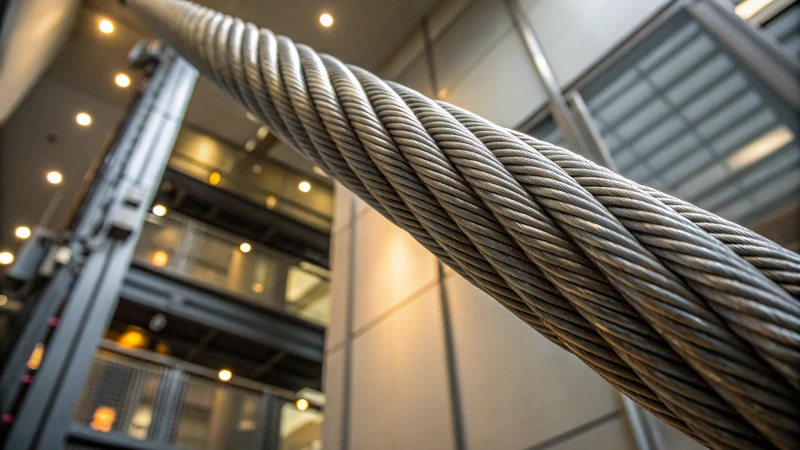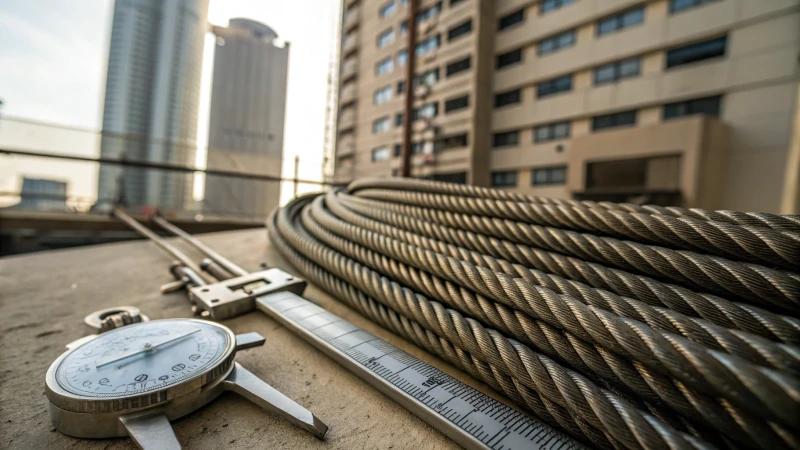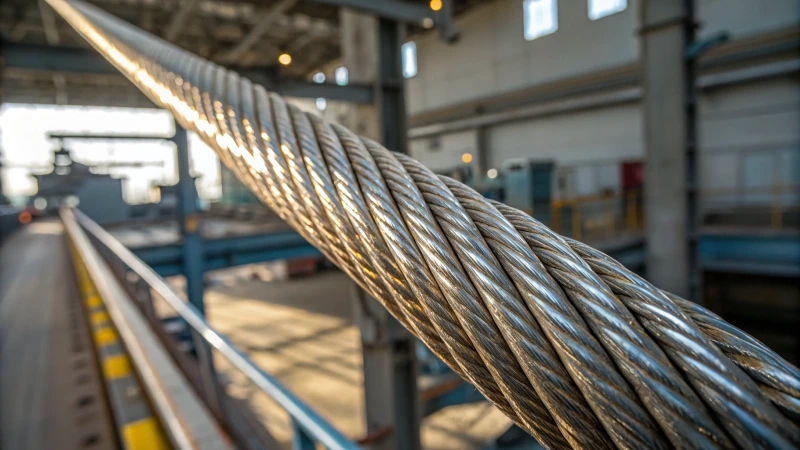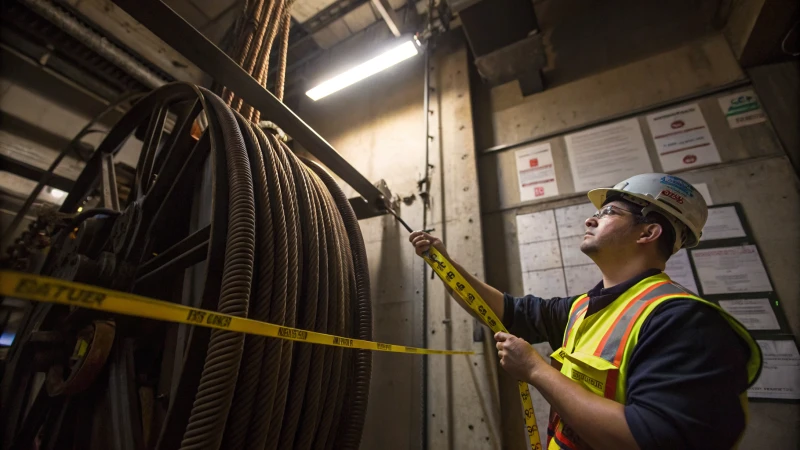
I still remember the first time I stood in front of a high-capacity passenger elevator, marveling at its engineering prowess.
Steel wire ropes are ideal for high-capacity passenger elevators due to their unmatched tensile strength, excellent fatigue resistance, and superior load-carrying capacity. Typically crafted in 7×19 or 6×36 configurations, they provide the durability and reliability essential for demanding elevator applications.
I couldn't help but wonder about the components working tirelessly behind the scenes. That's when I learned about the incredible role steel wire ropes play. Their robustness isn't just about strength—it's about ensuring every ride is smooth and safe, day after day. These ropes aren't just holding up the elevator; they're holding up our trust in technology. By understanding international standards and exploring options like corrosion-resistant coatings, we can appreciate why steel wire ropes remain the unsung heroes of modern elevators.
Steel wire ropes have superior load-carrying capacity.True
Steel wire ropes are designed to handle heavy loads efficiently.
7×19 configuration is less durable than 6×36 for elevators.False
Both configurations offer durability; choice depends on specific needs.
Why is Tensile Strength Important in Elevator Wire Ropes?
Have you ever wondered what keeps elevator rides smooth and safe?
Tensile strength in elevator wire ropes is essential as it determines the maximum stress these ropes can handle before failing, ensuring elevators operate safely and efficiently carry loads.

The Role of Tensile Strength in Load-Bearing
I remember the first time I had to evaluate the wire ropes for a high-rise project. It hit me how crucial tensile strength is. These ropes are like the unsung heroes, constantly bearing the weight of elevator cars and their passengers. Tensile strength1 tells us just how much stress a rope can handle without snapping, which is vital for safety.
Think about high-capacity elevators that need ropes with tensile strengths over 2000 MPa. They're built using configurations like 7×19 or 6×36 to boost their load-carrying ability and resilience against fatigue. It's like having a reliable friend who can always lift you up when you're down.
| Rope Configuration | Load-Bearing Capacity |
|---|---|
| 7×19 | High |
| 6×36 | Very High |
Safety Standards and Compliance
Meeting safety standards like ISO 4344 isn't just a box to tick; it's a commitment to reliability over time. Regular testing for fatigue and wear ensures that these ropes do their job without a hitch. I’ve seen firsthand how using ropes with the right tensile strength can lead to fewer breakdowns and longer service life.
Material Considerations: Stainless Steel vs. Galvanized
When working on projects in environments with high humidity or salinity, choosing stainless steel ropes has been a game-changer. They offer not just high tensile strength but also resist corrosion, sometimes extending service life by 25%-40% compared to galvanized options2. This choice affects not just durability but how often you need to carry out maintenance.
Factors Influencing Tensile Strength
- Material Composition: The alloy mix plays a big role in tensile properties. I've often chosen AISI/SUS 304/316 stainless steels for their balance of strength and corrosion resistance.
- Rope Construction: Different constructions provide varying tensile strengths. Picking the right one is like choosing the right tool for a job.
- Coatings: Protective coatings are like armor, shielding ropes from environmental wear and helping them maintain their tensile integrity.
Understanding these factors helps me make informed decisions, ensuring the wire ropes we select are up to the task and comply with regulations. This knowledge isn't just about ticking boxes; it ensures operational efficiency and safety across industries.
Explore more about steel compositions3 to gain deeper insights into making the right choice for your elevator systems.
Elevator ropes with 6×36 configuration have very high load capacity.True
The 6×36 configuration is designed for very high load-bearing capacity.
Galvanized ropes have higher tensile strength than stainless steel ropes.False
Stainless steel ropes generally offer higher tensile strength and corrosion resistance.
How does wire rope construction influence elevator performance?
Remember that time when you got stuck in an elevator, and all you could think about was how reliable those cables should be?
Wire rope construction affects elevator performance by determining the load capacity, fatigue resistance, and overall durability. Different constructions, like 7×19 or 6×36, offer unique advantages such as enhanced tensile strength and flexibility, which are crucial for demanding elevator applications.

Types of Wire Rope Constructions
I never imagined I'd be so fascinated by wire ropes until I started learning about their role in elevators. It's incredible how something as simple as the construction of these ropes can make such a big difference. For example, the 7×19 construction4 is all about flexibility and high tensile strength, making it perfect for high-capacity elevators.
On the flip side, the 6×36 construction5 is designed to resist fatigue. Imagine having to endure constant start-stop operations; this design is like the marathon runner of wire ropes!
| Construction | Strands | Wires per Strand | Advantages |
|---|---|---|---|
| 7×19 | 7 | 19 | Flexibility, high strength |
| 6×36 | 6 | 36 | Fatigue resistance |
Impact on Load Capacity and Safety
The choice of wire rope construction isn't just about strength; it's about safety too. High tensile strength ropes can support heavier loads, which is critical in bustling office buildings where elevators are in constant use. Stainless steel ropes with corrosion-resistant coatings are like a trusty friend who never lets you down—they enhance both safety and longevity.
Regular fatigue testing, guided by ISO 4344 standards, ensures these ropes stay reliable over time. Elevators using coated ropes can enjoy a 25%-40% increase in service life6, which means fewer headaches and more peace of mind.
Fatigue Resistance and Wear
When elevators are used frequently, fatigue resistance becomes a top priority. The type of construction determines how well a wire rope can handle the pressure of constant use without falling apart. For commercial settings, having ropes that can endure stress without compromising safety is like having a superhero on your team.
Coated ropes are the unsung heroes here, preventing wear from environmental factors and ensuring consistent performance. As someone who might be choosing these ropes for specific applications, understanding these factors is crucial for making the best choice.
Importance of Standards and Testing
Adhering to industry standards like ISO 4344 is like having a roadmap to safety and performance excellence. Regular testing for fatigue and wear is essential to maintaining operational safety. Suppliers who provide ropes meeting these standards offer not just products but peace of mind.
In conclusion, choosing the right wire rope construction is vital for optimizing elevator performance. You want factors like tensile strength, flexibility, and fatigue resistance to align perfectly with the elevator's operational demands, ensuring both safety and efficiency.
7×19 wire ropes offer higher tensile strength than 6×36.True
7×19 construction provides flexibility and high tensile strength, ideal for heavy loads.
Coated ropes increase elevator service life by 50%.False
Coated ropes can increase service life by 25%-40%, not 50%.
Why is Corrosion Resistance Essential for Elevator Safety?
When I first learned about elevator safety, I never realized how much corrosion resistance mattered. It's a hidden hero in ensuring that elevators run smoothly and safely, especially in damp environments.
Corrosion resistance is crucial for elevator safety, ensuring that components like cables and rails remain durable and reliable. This prevents mechanical failures, particularly in moisture-prone areas, maintaining safety standards.

Understanding Corrosion in Elevator Components
I remember walking into an old building with creaky elevators and wondering how safe they really were. Elevators are made up of various metal components, such as cables and rails. In humid or corrosive environments, these metals can deteriorate, leading to potential safety hazards. Corrosion resistance helps keep these parts in good condition over time, reducing the risk of mechanical failure7 and ensuring everyone's safety.
Importance of Material Selection
Choosing the right materials for elevator construction is like picking the right ingredients for a recipe—crucial for success. Stainless steel, known for its corrosion-resistant properties, is often the go-to choice. It can handle tough conditions and extend the life of elevator components by 25%-40%, according to industry standards8. This makes it ideal for coastal areas or buildings with high humidity.
| Material | Corrosion Resistance | Typical Usage |
|---|---|---|
| Stainless Steel | High | Cables, Rails |
| Galvanized Steel | Medium | Supports |
| Aluminum | Low | Panels |
Regular Maintenance and Testing
Think of regular maintenance as a health check-up for your elevator. ISO 4344 standards recommend routine fatigue and wear testing, especially for elevators that work hard every day. Coated ropes have shown increased service life in demanding environments. Maintenance teams should be like detectives, always on the lookout for early signs of corrosion to prevent costly repairs9 or replacements.
Technological Innovations in Corrosion Resistance
When I hear about advancements in technology, I get excited about the possibilities they bring. In the world of elevators, innovative coating technologies have significantly improved corrosion resistance. These coatings create protective barriers against corrosive elements, enhancing the durability of metal parts. Such developments are crucial for ensuring the ongoing safety and reliability of elevators in challenging environments like coastal or industrial areas.
Cost Implications of Corrosion
Ignoring corrosion resistance can be like ignoring a slow leak in your roof—it only gets more expensive over time. Frequent replacements and repairs can drive maintenance costs through the roof. By investing in corrosion-resistant materials, building managers can reduce long-term expenses and ensure safer operations. Understanding these cost dynamics is vital for procurement officers who need to source materials that comply with safety regulations10.
Stainless steel extends elevator component life by 25%-40%.True
Stainless steel's corrosion resistance increases durability, extending life by 25%-40%.
Ignoring corrosion resistance leads to lower maintenance costs.False
Neglecting corrosion resistance raises costs due to frequent repairs and replacements.
Why is Regular Testing and Maintenance of Elevator Ropes Essential?
Have you ever been in an elevator, holding your breath as it creaked its way up? Let's dive into why maintaining those ropes is more than just about avoiding awkward elevator silence.
Regular testing and maintenance of elevator ropes are crucial for ensuring safety, preventing breakdowns, and prolonging service life. Routine inspections help identify wear and fatigue early, minimizing risks and costly repairs.

Understanding Elevator Rope Components
When I first learned about elevator ropes, it reminded me of a time I replaced the brakes on my car. Much like those cables keeping my car safe, elevator ropes are made of high-tensile steel wires. They come in constructions like 7×19 or 6×36, offering increased load capacity11 and fatigue resistance. These robust materials are carefully chosen to meet the demanding needs of high-capacity passenger elevators.
Importance of Regular Testing
I remember the day I realized the importance of regular testing—when my car's check engine light wouldn't turn off despite my best efforts. In elevators, routine testing is like that light; it helps spot wear and fatigue before they cause failures. According to ISO 4344 standards12, regular inspections are mandatory for operational integrity. It's all about catching issues early to avoid unexpected downtime and ensure that everything keeps running smoothly.
Maintenance Strategies
My friend once joked that maintaining an elevator is like owning a vintage car—constant care and attention go a long way. Maintenance involves lubrication, adjustment, and replacement of worn-out components. Using corrosion-resistant coatings on ropes can extend their service life by 25%-40% in tough environments, ensuring longevity and safety13.
| Inspection Frequency | Action Required | Benefit |
|---|---|---|
| Monthly | Visual inspection | Early detection of wear |
| Quarterly | Lubrication | Reduces friction and corrosion |
| Annually | Load testing | Ensures capacity compliance |
Safety Compliance and Standards
I can't stress enough how crucial it is to follow safety standards like ISO. Think of it like wearing a seatbelt—it's there to keep us safe. Non-compliance can lead to severe penalties and safety hazards. Therefore, understanding regulatory requirements14 is essential for all building managers.
Economic Implications
It's tempting to skip maintenance to save money, but neglect can lead to costly breakdowns. I learned this the hard way with my car battery dying unexpectedly. Investing in regular checks saves money in the long run by avoiding extensive damage and maintaining the value of assets15. It’s a classic case of "a stitch in time saves nine."
Elevator ropes need monthly visual inspections.True
Monthly inspections help detect early signs of wear, preventing failures.
Corrosion-resistant coatings reduce rope lifespan by 25-40%.False
Coatings extend service life by 25-40%, not reduce it, in harsh environments.
Conclusion
Steel wire ropes, known for their tensile strength and fatigue resistance, are essential for high-capacity elevators, ensuring safety and reliability through regular testing and corrosion-resistant materials.
-
Learn about stress limits to ensure your wire ropes handle elevator loads safely. ↩
-
Compare materials to choose the best option for durability and resistance. ↩
-
Explore steel types used in wire ropes to enhance performance and strength. ↩
-
Explore how 7x19 construction offers flexibility and tensile strength ideal for elevators. ↩
-
Learn about the fatigue resistance benefits of 6x36 construction for frequent-use elevators. ↩
-
Discover how coated ropes enhance durability by resisting wear from environmental factors. ↩
-
Discover how corrosion leads to mechanical failures and affects elevator safety. ↩
-
Learn about industry standards for materials used in elevator construction. ↩
-
Explore the financial impact of neglecting corrosion resistance in elevators. ↩
-
Understand safety regulations related to corrosion resistance in elevators. ↩
-
Explore different elevator rope constructions to understand their load capacity and fatigue resistance benefits. ↩
-
Learn about the ISO standards that mandate regular inspections to ensure elevator safety. ↩
-
Discover how corrosion-resistant coatings can extend the lifespan of elevator ropes. ↩
-
Understand the regulatory requirements for maintaining safe elevator operations. ↩
-
Find out how regular maintenance saves costs by preventing extensive damage. ↩

